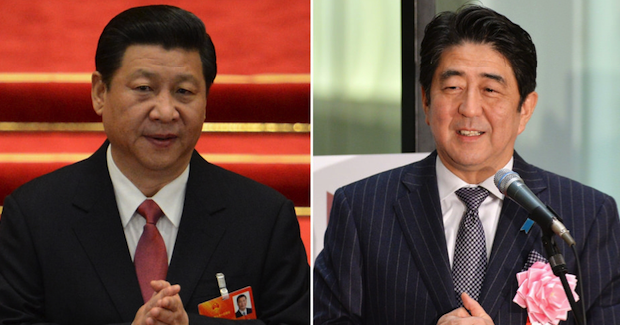Sino-Japanese Competition and ASEAN

One of the most striking features of post-Cold War East Asia has been having China and Japan strong and affluent at the same time and the growing rivalry between the two. So how do South-East Asian elites view Sino-Japanese competition? And how does this influential group perceive the role of ASEAN in managing the competition?
One of the biggest challenges for the East Asian region today is the Sino-Japanese relationship. Starting with the fishing trawler incident in September 2010, followed by Japan’s nationalisation of the Senkaku/Diaoyu Islands, this relationship is experiencing an escalation of tensions in most, if not all, areas of the bilateral relationship. In response to the intensifying competition, China and Japan have elevated the importance of South-East Asia and the Association of Southeast Asian Nations (ASEAN) in their foreign policy strategies.
Focusing on how elites from five South-East Asian states—Indonesia, Malaysia, the Philippines, Singapore and Vietnam—perceive the engagement of China and Japan with the region, this article poses two questions: (1) How do South-East Asian elites view Sino-Japanese competition? and (2) How do South-East Asian elites view the role of ASEAN in managing the competition? The analysis here concludes that while some South-East Asian elites see opportunities in the Sino-Japanese competition, they nevertheless do not perceive it as an issue of critical significance. Instead, the concern lies generally with major-power dynamics, and particularly with Sino-US relations. ASEAN is viewed as lacking the ability to manage the negative consequences of Sino-Japanese competition, although its external balancing function has perceptibly helped to restrain any escalation of major-power tensions.
Competition in South-East Asia
South-East Asia became an important source for resources and markets for Japan’s rise as an economic power during the Cold War. Japan established dialogue partner status with ASEAN in 1977 following the implementation of the Fukuda Doctrine, which led to the development of Japan–ASEAN relations based on mutual trust. China’s development of relations with South-East Asia mainly grew in the post-Cold War period. After establishing formal relations with members of ASEAN, China became a dialogue partner of ASEAN in 1996.
The structural condition of China’s rise and Japan’s stagnation gave rise to the competitive behaviour from the two East Asian giants. The goal was to augment one’s influence at the expense of the other through the implementation of a comprehensive foreign policy strategy that covered the economic, political and diplomatic domains. Sino-Japanese competition expressed in South-East Asia has occurred outside the traditional power-based understanding of military competition, primarily in the non-traditional security space, such as the East Asian multilateral order, South China Sea disputes, and engagement in the subregion encompassing Cambodia, Laos, Myanmar and Vietnam (CLMV).
Elite perceptions
Generally, the interviewees from most of the selected South-East Asian countries, who are actively involved in Track 1.5 and Track 2 diplomacy, did not seem to pay much attention specifically to the Sino-Japanese competition. Those from the Philippines were the exception, as they appeared to be much more concerned with the issue. For the other South-East Asian respondents, their attention was less on the Sino-Japanese competition and more on major-power dynamics in general, particularly the impact of Sino-US relations on regional states. Three reasons explain the low level of interest among South-East Asia countries in the Sino-Japanese competition.
First, the interviewees were united in the view that the tensions between the two East Asian powers would not escalate into an open conflict, due to the high economic interdependence and common economic interests between China and Japan. In 2014, China was Japan’s top trading partner, while Japan was China’s third-largest trading partner.
Second, rather than being wary about the competition, some of the respondents perceived the elevated level of engagement by China and Japan with ASEAN and South-East Asian countries as an opportunity in a range of areas, such as economics, capacity-building and infrastructure development. Being China’s rival claimants in the South China Sea, the Philippines and Vietnam have sought assistance from Japan to build their maritime and defence capabilities.
Third, for most of the interviewees, the Sino-US relationship remained the most important one for the region, over and above Sino-Japanese relations. Even among the Philippine respondents, a senior academic actively involved in Track 2 processes highlighted that Japan was a reminder to China of the US presence in the region. In other words, Japan was seen largely as a US proxy. It also suggests that, broadly, South-East Asian elites view a rising China as a genuine contender to US superiority in the existing regional order, and they are generally unsure of the impact that a rising China will have on the stability of the region.
ASEAN’s role
How do South-East Asian elites perceive the role of ASEAN, as an institution, in managing the competition? Here, the interviewees perceived ASEAN to lack the ability to manage the negative consequences of the Sino-Japanese competition, but at the same time acknowledged that the association could continue to play an external balancing role through forging positive partnerships with and among all the extra-regional powers. This reinforces the effectiveness of the regional architecture in limiting major-power tensions.
ASEAN’s inability to manage the negative consequences of the Sino-Japanese competition was viewed to be the result of two factors. First, the association was seen as too small and too far removed from the Sino-Japanese competition to have any significant role in managing its adverse effects. As several respondents from Indonesia put it, the Sino-Japanese competition was rooted in sources that were beyond Indonesia’s and South-East Asia’s immediate geostrategic environment, and therefore ASEAN was in no position to manage this competition. Other respondents expressed similar pessimism given that Sino-Japanese competition not only involved two East Asian giants, but also reflected a bigger contest between China and the US for regional and international influence.
Second, the South-East Asian elites also underscored the divisions in ASEAN as an obstacle to any role the association might collectively aspire to play in reducing Sino-Japanese tensions. Track 2 and think-tank security analysts from Indonesia observed that ASEAN member states were already individually aligned with either China or Japan, while other respondents noted more generally the disunity among ASEAN countries that could challenge the association’s effectiveness and relevance in the regional architecture.
Despite the extant pessimism, there was recognition of ASEAN’s utility in ensuring regional stability through its external balancing role in preserving the broad interests of its member states vis-à-vis the major powers. An interviewee from Malaysia, when challenged with the view that ASEAN was only a ‘talk shop’, responded that ASEAN had managed to build a web of formal and informal ties over the years; the “countless meetings” led by ASEAN each year had allowed various stakeholders to communicate with each other, thus averting miscalculations and reducing the likelihood of conflict.
Conclusion
In light of the escalating competition between China and Japan, and their respective strategies to enhance relations with South-East Asian states and ASEAN, this article has presented South-East Asian elites’ views of the Sino-Japanese competition, as well as their perceptions of ASEAN’s role in managing this major-power relationship. Based on a range of sources, including interviews conducted in five South-East Asian countries, we conclude that while the Sino-Japanese competition is viewed to present some opportunities for South-East Asian countries, it is generally not perceived as an issue of critical significance. Instead, the concern lies more with major-power dynamics as a whole, and in particular with the Sino-US relationship. Given that Japan and the US are treaty allies, the Sino-Japanese competition is also viewed as a reflection of broader Sino-US dynamics.
ASEAN is perceived to have a limited role in managing the Sino-Japanese competition not only because the rivalry is viewed to be beyond ASEAN’s remit, but also because of what is seen as ASEAN’s own failing—namely, the divisions among its member states. As East Asian stability is largely dependent on strategic ambiguity among the major powers, it is incumbent on ASEAN member states to forge positive partnerships with the various stakeholders. An open and inclusive regional architecture that involves all the major powers would also reduce the risk of external interference in South-East Asia’s affairs and allow ASEAN, even if only in appearance, the autonomy to lead in decision-making processes for its own region. In this sense, being perceived as an effective convener in the region would help ASEAN to sustain its long-term relevance and central role in the East Asian architecture.
Bhubhindar Singh is associate professor and coordinator of the Regional Security Architecture Programme at the S. Rajaratnam School of International Studies (RSIS), Nanyang Technological University (NTU), Singapore.
Sarah Teo is associate research fellow with the Regional Security Architecture Program at RSIS, NTU, Singapore.
Benjamin Ho is an associate professor of economics at RSIS, NTU.
This article is an extract from the authors’ article in Volume 71, Issue 1 of the Australian Journal of International Affairs, ‘Rising Sino-Japanese Competition: Perspectives from South East Asian Elites’. It is republished with permission.



